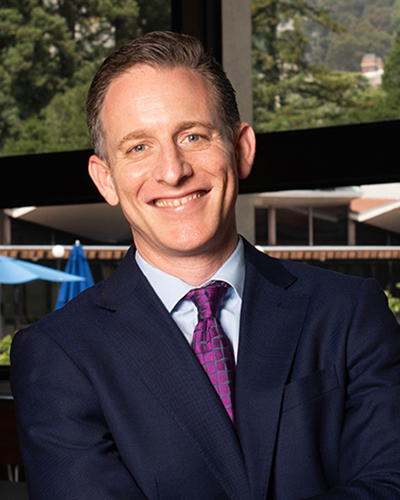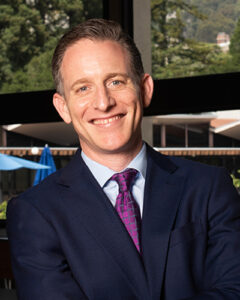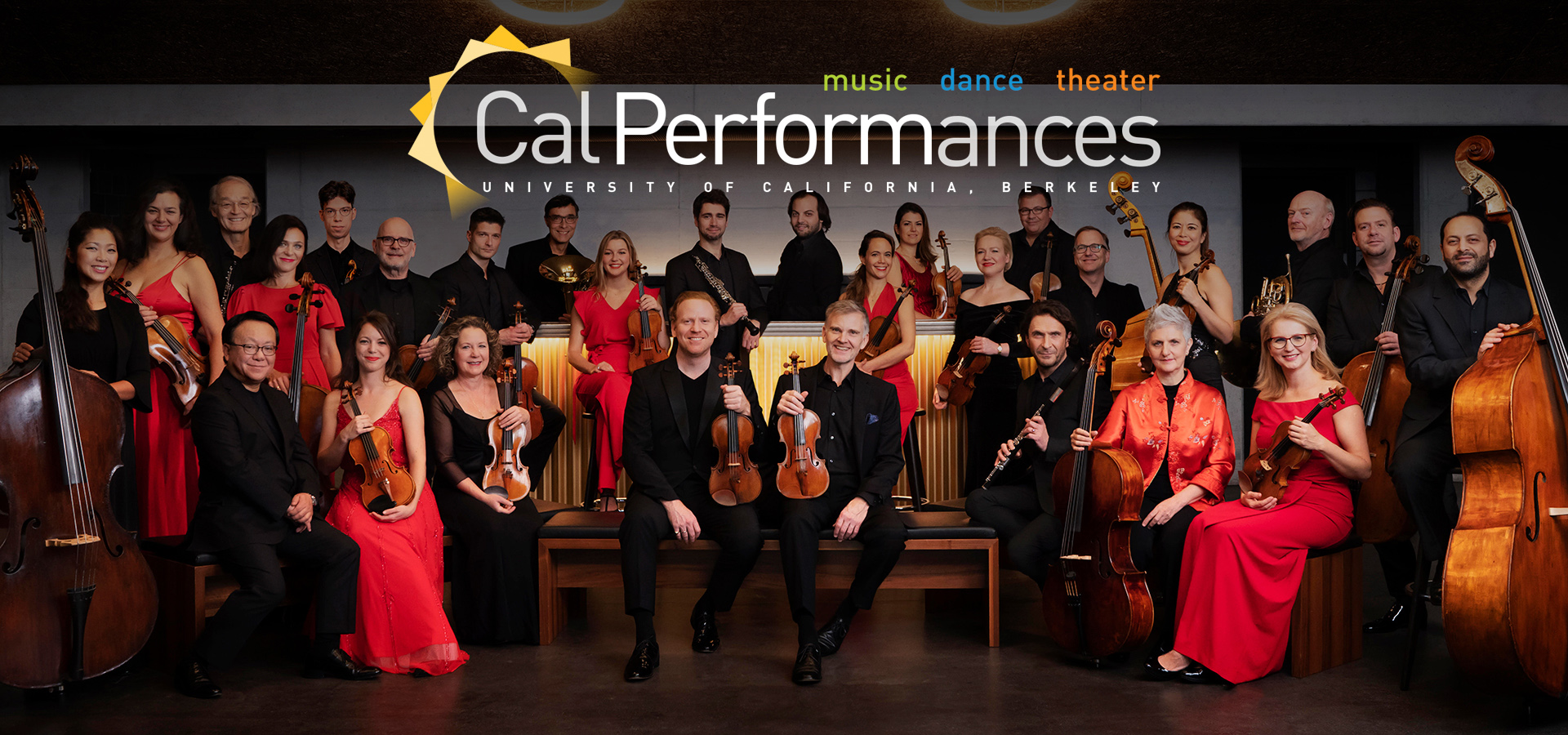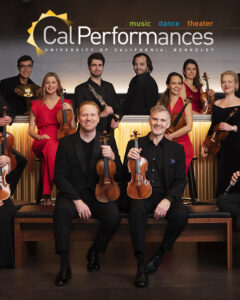Zurich Chamber Orchestra
Daniel Hope, solo violin and music director
Willi Zimmermann, concertmaster
Willi Zimmermann, concertmaster
Sunday, March 26, 2023, 5pm
Zellerbach Hall
This performance is made possible, in part, by Jerome and Thao Dodson.
Run time for this concert is approximately 2 hours, including intermission, but not including any possible encores.
From the Executive and Artistic Director

It would be hard to exaggerate the depth and breadth of Cal Performances’ programming this month, a schedule distinguished by the culmination of our season-long, campus-wide residency honoring the visionary work of South African artist William Kentridge—the man the UK’s Guardian described as “continuously original, deeply humane, and vividly thought-provoking…one of the great artists of our time.” Residency events include the US premiere of Kentridge’s musical and theatrical work SIBYL at Zellerbach Hall (for more, see Thomas May’s excellent article, beginning on the next page), including a special gala honoring the artist; a presentation of the Dadaist poem Ursonate, performed by Kentridge himself; a staging of A Guided Tour of the Exhibition: For Soprano and Handbag, a bold and innovative work created by Kentridge and Joanna Dudley (who will also perform it); a retrospective of Kentridge’s films; the visual lecture To What End; and classroom conversations. We’re thrilled to play a major role in this extraordinary artistic endeavor and thank our partners—the Berkeley Art Museum and Pacific Film Archive (BAMPFA) and the Townsend Center for the Humanities—for their contributions to this great celebration.
During any other month, the Kentridge Residency would be more than enough to trumpet. But March at Cal Performances will also see a return engagement by the storied Vienna Philharmonic Orchestra, under conductor Christian Thielemann (making his Bay Area concert debut). Over the course of three programs at Zellerbach Hall, the orchestra will traverse a century of canonic repertoire—from the heroic music of Viennese classicism, through several generations of opulent Austro-German Romanticism, to the expanded sonorities of the Second Viennese School near the turn of the 20th century. These works showcase the mighty Vienna musicians at their finest, artists renowned for playing both “rich in detail and fearsome in its intensity” (The Guardian).
If all of this weren’t enough, we’ll also see a long-anticipated visit by New Orleans’ legendary Preservation Hall Jazz Band celebrating its 60th anniversary this year with a rousing program of traditional jazz, gutbucket funk, Afro-Cuban rhythms, folk, and pop; and a performance of Handel’s great oratorio Solomon (1748) with the renowned English Concert, the Clarion Choir, and an impressive array of guest vocalists. Our great friend Zakir Hussain returns with his ever-popular Masters of Percussion; the London-based Castalian Quartet makes its Cal Performances debut with a program that ranges from Haydn to Schubert to a haunting 2006 work by contemporary Finnish composer Kaija Saariaho; and we’ll cap off the month with concerts by the international all-woman jazz supergroup Artemis and the accomplished Zurich Chamber Orchestra with music director and violinist Daniel Hope.
Upcoming Illuminations: “Human and Machine” programming (much of it presented in conjunction with the Kentridge Residency) will continue to take advantage of Cal Performances’ unique positioning as a vital part of the world’s top-ranked public university. As we’ve done all
season long, we’ll be engaging communities on and off campus to examine the evolution of tools such as musical instruments and electronics, the complex relationships between the creators and users of technology, the possibilities enabled by technology’s impact on the creative process, and questions raised by the growing role of artificial intelligence in our society.
Please make sure to check out our brochures and our website for complete information about upcoming events. And stay tuned in April, when we announce our 2023–24 season; we’ve got plenty of exciting news for you.
Thank you for joining us at Cal Performances!
Jeremy Geffen
Executive and Artistic Director, Cal Performances
 It would be hard to exaggerate the depth and breadth of Cal Performances’ programming this month, a schedule distinguished by the culmination of our season-long, campus-wide residency honoring the visionary work of South African artist William Kentridge—the man the UK’s Guardian described as “continuously original, deeply humane, and vividly thought-provoking…one of the great artists of our time.” Residency events include the US premiere of Kentridge’s musical and theatrical work SIBYL at Zellerbach Hall (for more, see Thomas May’s excellent article, beginning on the next page), including a special gala honoring the artist; a presentation of the Dadaist poem Ursonate, performed by Kentridge himself; a staging of A Guided Tour of the Exhibition: For Soprano and Handbag, a bold and innovative work created by Kentridge and Joanna Dudley (who will also perform it); a retrospective of Kentridge’s films; the visual lecture To What End; and classroom conversations. We’re thrilled to play a major role in this extraordinary artistic endeavor and thank our partners—the Berkeley Art Museum and Pacific Film Archive (BAMPFA) and the Townsend Center for the Humanities—for their contributions to this great celebration.
It would be hard to exaggerate the depth and breadth of Cal Performances’ programming this month, a schedule distinguished by the culmination of our season-long, campus-wide residency honoring the visionary work of South African artist William Kentridge—the man the UK’s Guardian described as “continuously original, deeply humane, and vividly thought-provoking…one of the great artists of our time.” Residency events include the US premiere of Kentridge’s musical and theatrical work SIBYL at Zellerbach Hall (for more, see Thomas May’s excellent article, beginning on the next page), including a special gala honoring the artist; a presentation of the Dadaist poem Ursonate, performed by Kentridge himself; a staging of A Guided Tour of the Exhibition: For Soprano and Handbag, a bold and innovative work created by Kentridge and Joanna Dudley (who will also perform it); a retrospective of Kentridge’s films; the visual lecture To What End; and classroom conversations. We’re thrilled to play a major role in this extraordinary artistic endeavor and thank our partners—the Berkeley Art Museum and Pacific Film Archive (BAMPFA) and the Townsend Center for the Humanities—for their contributions to this great celebration.
During any other month, the Kentridge Residency would be more than enough to trumpet. But March at Cal Performances will also see a return engagement by the storied Vienna Philharmonic Orchestra, under conductor Christian Thielemann (making his Bay Area concert debut). Over the course of three programs at Zellerbach Hall, the orchestra will traverse a century of canonic repertoire—from the heroic music of Viennese classicism, through several generations of opulent Austro-German Romanticism, to the expanded sonorities of the Second Viennese School near the turn of the 20th century. These works showcase the mighty Vienna musicians at their finest, artists renowned for playing both “rich in detail and fearsome in its intensity” (The Guardian).
If all of this weren’t enough, we’ll also see a long-anticipated visit by New Orleans’ legendary Preservation Hall Jazz Band celebrating its 60th anniversary this year with a rousing program of traditional jazz, gutbucket funk, Afro-Cuban rhythms, folk, and pop; and a performance of Handel’s great oratorio Solomon (1748) with the renowned English Concert, the Clarion Choir, and an impressive array of guest vocalists. Our great friend Zakir Hussain returns with his ever-popular Masters of Percussion; the London-based Castalian Quartet makes its Cal Performances debut with a program that ranges from Haydn to Schubert to a haunting 2006 work by contemporary Finnish composer Kaija Saariaho; and we’ll cap off the month with concerts by the international all-woman jazz supergroup Artemis and the accomplished Zurich Chamber Orchestra with music director and violinist Daniel Hope.
Upcoming Illuminations: “Human and Machine” programming (much of it presented in conjunction with the Kentridge Residency) will continue to take advantage of Cal Performances’ unique positioning as a vital part of the world’s top-ranked public university. As we’ve done all
season long, we’ll be engaging communities on and off campus to examine the evolution of tools such as musical instruments and electronics, the complex relationships between the creators and users of technology, the possibilities enabled by technology’s impact on the creative process, and questions raised by the growing role of artificial intelligence in our society.
Please make sure to check out our brochures and our website for complete information about upcoming events. And stay tuned in April, when we announce our 2023–24 season; we’ve got plenty of exciting news for you.
Thank you for joining us at Cal Performances!
Jeremy Geffen
Executive and Artistic Director, Cal Performances
About the Performance
From the earliest days of written music, and probably long before, composers have recycled ideas from their own works or from those of others. The process has ranged from allusion to a few notes from a familiar sacred chant or treasured folksong to advanced techniques of parody, in which a melody from an existing piece might serve as the structural foundation for a new, often much more elaborate composition. The works on today’s program offer a sense of how the great legacy of Baroque music, with its complex language of emotions and intricate polyphony, cast its influence far into the future. The fugal counterpoint of Elgar’s Introduction and Allegro, the anxious mood sustained by Mendelssohn in the opening movement of his early Violin Concerto in D minor, and the rich musical mix of Max Richter’s Recomposed: Vivaldi – The Four Seasons, show how the past and present can coexist in vigorous creative dialogue.
Elgar’s exceptional skills as an orchestrator were founded on his competence as a violinist. He proved a sufficiently able player during his youth to secure freelance orchestral work and a regular post in William Stockley’s Band in the English industrial city of Birmingham. Elgar directed his practical knowledge of the instrument into the intricately detailed string writing of his mature works, often hallmarked by rich chordal sonorities and intricate polyphony. The Introduction and Allegro, first performed in 1905 by the recently established London Symphony Orchestra under the composer’s direction, emulates the character of the Baroque concerto grosso in its exchanges between a string quartet and a larger group of strings.
Here, Elgar makes heavy technical demands on the players; moreover, he fills the score with a multitude of expression marks, dynamic shadings, and performance indications that require sustained emotional engagement with the music: this is not a work of half-measures. There is a tension here between virtuoso display and introspection, most likely rooted in the personal life of a composer already feted as one of the great adornments of Edwardian England’s cultural life yet one troubled by recurrent episodes of depression and self-doubt. The undermining drag of anxiety runs through the contrasting thematic ideas set out in the Introduction and explored more fully in the Allegro. Elgar recalled how the Introduction’s exquisite solo viola tune was inspired by memories of snatches of folksong heard in the distance while on holiday in Wales. The Allegro’s closing section includes what the composer described as “a devil of a fugue,” the demonic intensity of which gives way to a rapid tour through the work’s main themes, an impassioned restatement of the Introduction’s opening and a majestic recall of the “Welsh” theme.
Felix Mendelssohn began studying composition around the time of his 10th birthday with Karl Friedrich Zelter, a devotee of the music of Johann Sebastian Bach, and violin with the Prussian court violinist C.W. Henning. The supremely talented boy put his lessons in counterpoint and string playing to the test in a dozen symphonies for strings and the Violin Concerto in D minor (c. 1822), the latter notably free from the ostentatious virtuosity cultivated by such contemporary violin-composers as Viotti and Kreutzer. Mendelssohn promotes the dialogue between soloist and orchestra in this concerto, established in the opening Allegro’s eloquent interplay of thematic ideas and celebrated in its vivacious rondo finale. The work’s introduction echoes the style of a Baroque aria, tinged by defiance and despair, while the slow movement begins with a graceful triple-time melody reminiscent of Mozart. Although written for Eduard Rietz, Mendelssohn’s second violin teacher, the concerto remained unperformed until the piece was shown to Yehudi Menuhin in 1951 and premiered by him at Carnegie Hall the following year.
Vivaldi’s concertos, notably those published as L’estro armonico in 1711 and Il cimento dell’armonia e dell’inventione (‘The Contest between Harmony and Invention’) 14 years later, circulated widely in Europe. Their turn away from counterpoint towards a pared-down, radically simple manner of writing set the tone for a new style of writing; they also served as the basis for a series of transcriptions by J.S. Bach, in which he effectively recomposed 10 concertos by Vivaldi for solo harpsichord, solo organ, or four harpsichords and strings, adapting and enhancing each work to suit its new performing medium. Three centuries after Bach left his mark on Vivaldi’s music, Max Richter reimagined the first group of concertos from the Venetian composer’s Il cimento volume, collectively known as La quattro stagione (‘The Four Seasons’). Recomposed: Vivaldi – The Four Seasons (2012) presents one composer’s creative encounter with the work of another.
Like so many newcomers to classical music, Richter fell in love with The Four Seasons at an early age. His ardor survived despite the work’s overexposure in the concert hall and its so-called secondary exploitation in everything from soundtrack scores to customer service “music on hold” loops. “It’s part of our musical landscape,” he reflects. “I wanted to make the piece because I love [The Four Seasons]. So, it was my way of having a conversation with Vivaldi.” Richter’s engagement with musical revenants had earlier found a home in Memoryhouse (2002), an affecting collage inspired by 20th-century Europe’s troubled history and its cultural legacy. His debut solo album, with its postmodern mix of ambient sounds, recorded voices, electronics, and live instruments, attracted a cult following and set the ground for his subsequent neoclassical works.
Recomposed, first performed by Daniel Hope and the Britten Sinfonia at London’s Barbican Centre in 2012, deconstructs Vivaldi’s music, discarding around three-quarters of the original composition to leave a stock of his favorite melodies and longer fragments. The work opens with “Spring 0,” a restless polyphony of independent string parts out of which emerges “Spring 1,” a saturated blend of Vivaldi’s allusions to birdsong multiplied by chattering violins above a repeated chordal bass line. Vivaldi’s famous barking dog grows melancholy in “Spring 2,” as does Richter’s romantic solo violin tune that rises above it. “Spring 3” begins as a round dance and flourishes with an exquisite solo melody, one of several woven by the composer into the fabric of Vivaldi’s thematic threads.
“Summer 1” grows out of pure Vivaldi, charting the course of the concerto’s original opening before entering a new world of rhythmic loops that carry a soaring solo line. An abrupt halt clears the way for the mystical incantations of “Summer 2,” the meditative calm before the storm of “Summer 3.” The latter ends with an ethereal passage for strings and electronics, like something retrieved from the forbidden “Zone” of Tarkovsky’s Stalker. Richter subverts the rhythmic expectations of “Autumn 1,” with Vivaldi’s regular patterns altered by the omission of a note or rest here and addition of a syncopated repetition elsewhere. “Autumn 2” projects a Daliesque soundscape of melting chords and shifting shapes, while “Autumn 3” cultivates rhythmically complex layers of tone colors and textural fluctuations. The conversation across the centuries continues in “Winter 1,” with telling changes to Vivaldi’s rhythmic script and bold intensifications of the so-called Red Priest’s already vivid evocation of teeth set chattering by the cold. Recomposed: Vivaldi – The Four Seasons ends with two haunting echoes of melodic fragments, recast to remind listeners of the radical beauty and absorbing eloquence of Vivaldi’s masterwork.
—Andrew Stewart



